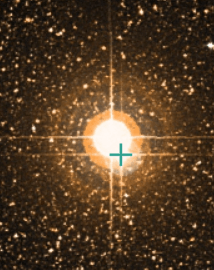Double Star of the Month:
15 Aquilae
AKA: h Aquilae; SHJ 286
Position: 19 hr 04 min 58 sec -04 degrees 01 min 53 sec
Due south at 22:30 (BST) on 15 August 2022
15 Aquilae, the cross is over 15 Aquilae B
Image: Simbad (http://simbad.u-strasbg.fr/simbad/)
If I had to name the best historical double star catalogue to use to find nice doubles, without any doubt I would recommend the South-Herschel catalogue. It contains a large number of relatively bright, easy to split and colourful doubles – what you might call crowd-pleasers. There are 378 doubles in the original catalogue, some of which do not appear to exist and while there is a South-Herschel designation for double stars, originally Sh now SHJ, many of them bear different designations, usually Struve (Σ or STF). But 15 Aquilae has a SHJ designation, namely SHJ 286. The famously irascible James South – he once smashed a telescope mount in a rage – and the young John Herschel observed these double stars between 1821 and 1823, some of which had previously been observed by John Herschel’s father William, and published their observations in Philosophical Transactions in 1824.
This is a very easy double to split but it is rather faint. To locate it find 3.4 magnitude Lambda Aquilae at the bottom of the constellation (if Altair is the eagle’s head, Lambda is its tail). Be careful, though, to make sure not to confuse Lambda Aquilae with the lower and dimmer star, 12 (or i) Aquilae (mag. 4.0). 15 (or h) Aquilae (mag. 5.4) is above and to the west of Lambda Aquilae and is roughly half-way between Lambda Aquilae and 14 (or g) Aquilae (also mag. 5,4). The two stars in 15 Aquilae are mag. 5.5 and 6.8 and have a wide separation of 39.6 arcseconds, but are an optical double not a binary. The primary star is a K1 giant star which is 14 times larger in radius than our Sun and is four billion years old. It lies on the galactic disc 314 light years away from us. The secondary is almost twice as far away at 641 light years, so they clearly cannot be connected. By chance it is also a K giant star, K3 in this case. As they are almost identical K stars, they should both be seen as yellow or orange, but as I have explained before the human eye revolts against this and the pair are often seen (and are seen by me) as yellow and blue. The famous double star observer Thomas Webb saw them as yellow-white and lilac and the modern observer Sissy Haas as amber-yellow and bluish turquoise. By contrast William Herschel when he first observed 15 Aquilae on 25 July 1781 saw them both as pale red (to see deep yellow stars as red is quite common). So what do you observe?
